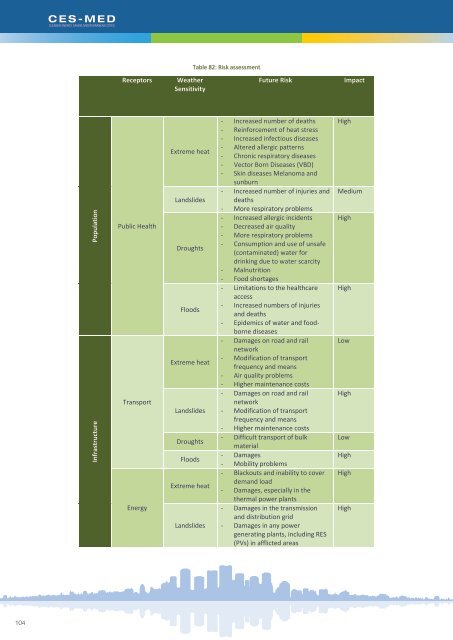161117_Jordan_ASEZA_SECAP_Revised
You also want an ePaper? Increase the reach of your titles
YUMPU automatically turns print PDFs into web optimized ePapers that Google loves.
In line to the above, the Southern and Eastern Mediterranean Countries (SEMCs) appear to<br />
be more vulnerable to climate change than the Northern Mediterranean Countries (NMCs).<br />
Indeed, they are, on the one hand, more exposed to accelerated desertification, soil aridity<br />
and water scarcity and, on the other hand, presenting economic structures that are more<br />
strongly dependent on natural resources, as well as technical and financial capacities that are<br />
too limited to help implement large-scale adaptation options [17].<br />
The Mediterranean, and more especially the Southern and Eastern rim, is and will be more<br />
affected by climate change than most other regions of the world in the course of the 21st<br />
century. The impacts of the rise in temperatures, the decrease in rainfall, the multiplication of<br />
the number and intensity of extreme events and the possible rise in sea level overlap and<br />
amplify the already existing pressures of anthropogenic origin on the natural environment.<br />
Through the crucial issue of scarcity of water resources, their impacts are fraught with<br />
consequences in the 21st century for human activities, in particular agriculture, fishery,<br />
tourism, infrastructures, urbanised coastal areas and hydropower production. In order to<br />
minimize as much as possible the economic losses and damages, several adaptation options<br />
must be thought out and implemented.<br />
Energy lies at the heart of the climate change issue. On the one hand, it is the main GHG<br />
emitting sector, and CO2 emissions in the future are likely to increase much more rapidly than<br />
the global average. On the other hand, hydropower production—relatively significant in<br />
certain countries (13% of power production in the SEMCs)—is affected by the climate as well<br />
as by the plant cooling constraints. Lastly, the energy demand (in particular, electricity) which<br />
is growing at a very high pace in the region, is likely to be further accelerated by the additional<br />
demand necessary to lessen the impacts of climate change (water desalination, airconditioning<br />
of buildings, etc.).<br />
4.2 National and Regional Strategy on Climate Change Adaptation<br />
<strong>Jordan</strong> signed the United Nations Framework Convention on Climate Change (UNFCCC) in<br />
1992 and ratified it in 1993. The main focal point for climate change issues in <strong>Jordan</strong> is the<br />
Ministry of Environment (MoE). After becoming the first country in the Middle East to develop<br />
a national climate change policy in 2013, <strong>Jordan</strong> has created a special directorate for Climate<br />
Change at the Ministry of Environment to act as a coordinating platform for all climate change<br />
activities in the country.<br />
Also, <strong>Jordan</strong> participates in the Paris Agreement, a world climate agreement reached within<br />
UNFCCC and during COP21, which focuses on bringing all nations into a common cause to<br />
undertake ambitious efforts to combat climate change and adapt to its effects. The Paris<br />
Agreement’s central aim is to strengthen the global response to the threat of climate change<br />
by keeping a global temperature rise this century well below 2 degrees Celsius above preindustrial<br />
levels and to pursue efforts to limit the temperature increase even further to 1.5<br />
degrees Celsius. Additionally, the agreement aims to strengthen the ability of countries to deal<br />
with the impacts of climate change. To reach these ambitious goals, appropriate financial<br />
flows, a new technology framework and an enhanced capacity building framework will be put<br />
93

















